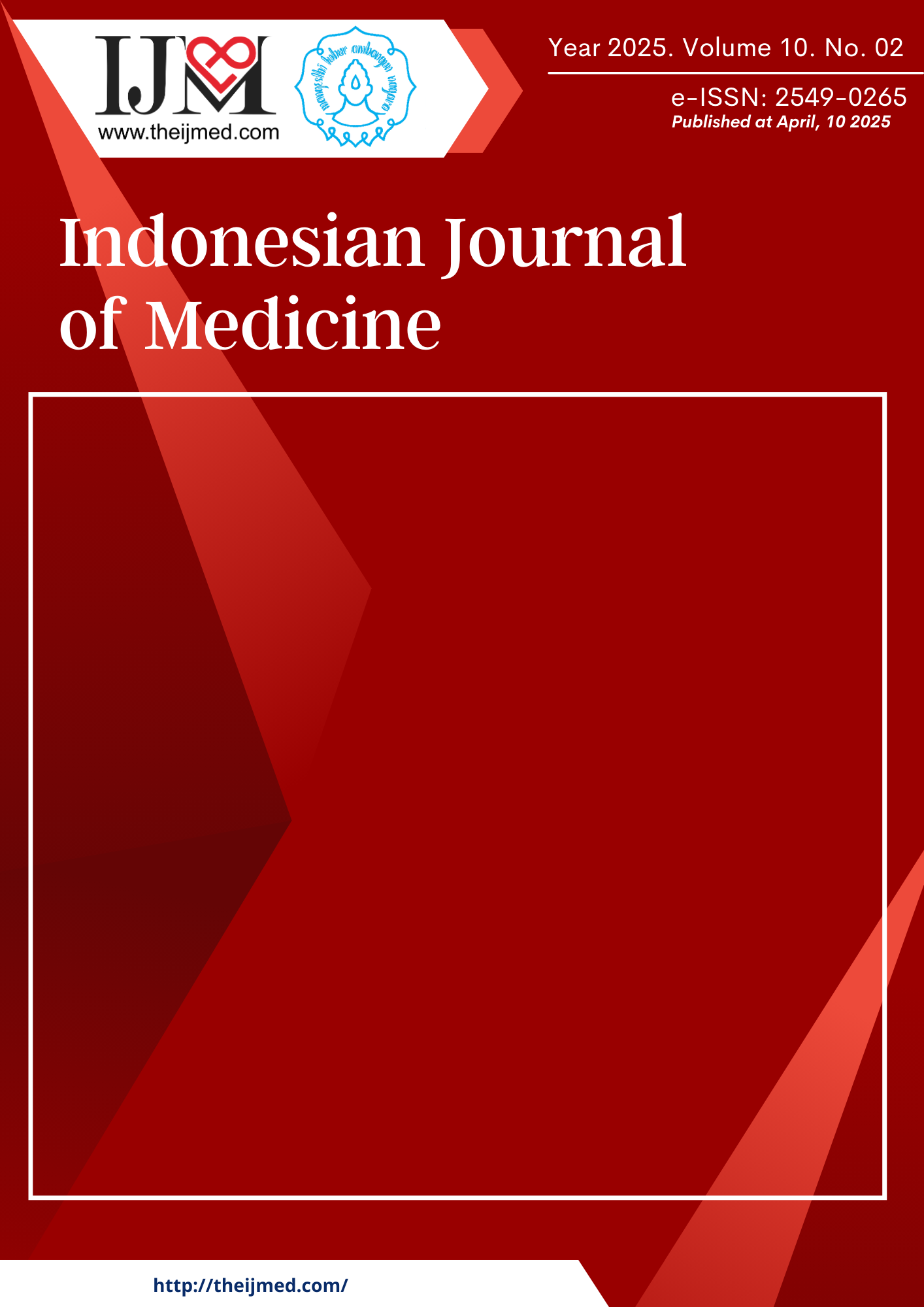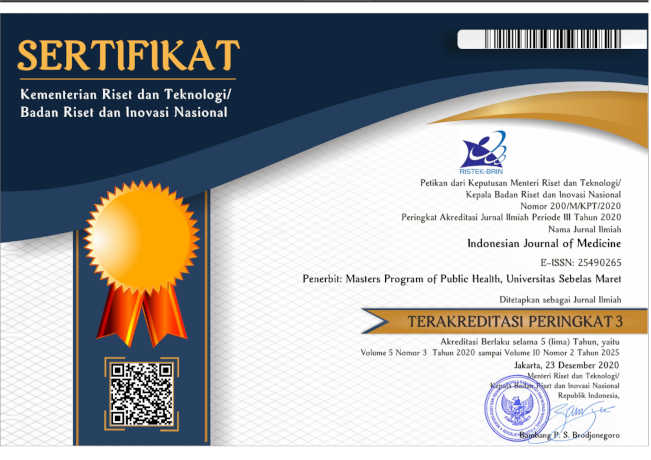Spatial Autocorrelation of Population Density, HIV/AIDS, and Diabetes Mellitus with Pulmonary Tuberculosis in Kupang, East Nusa Tenggara, Indonesia
DOI:
https://doi.org/10.26911/theijmed.2025.10.2.825Abstract
Background: The 2023 Global Tuberculosis (TB) Report ranks Indonesia second in the world for TB cases, with approximately 1,060,000 new cases and 134,000 deaths annually—equating to 17 deaths per hour. In East Nusa Tenggara (NTT) Province, pulmonary TB cases increased from 5,361 in 2020 to 5,184 in 2021, and significantly rose to 8,035 in 2022. Kupang Regency reported the highest number of TB cases in 2022. This study aimed to analyze the impact of risk factors, including population density, HIV/AIDS, and Diabetes Mellitus, on pulmonary TB cases using spatial analysis with the GeoDa application.
Subjects and Methods: This ecological study, conducted in Kupang, Indonesia, between October and November 2024, uses secondary data from 2021 to 2023 as the research sample. The study includes all recorded pulmonary TB patients from the Kupang Health Office, with 441 cases in 2021, 785 cases in 2022, and 979 cases in 2023.
Results: The Local Indicator of Spatial Association (LISA) test results show a low-high spatial relationship between HIV and TB variables in the Maulafa district for 2022-2023. Additionally, the diabetes mellitus (DM) and TB variables exhibit a High-Low spatial pattern in 2021 and a Low-High pattern in 2022 within the district. Regarding population density in 2021, a clustered spatial autocorrelation was observed (p-value = 0.049 < 0.05; [I] = 0.051 > E[I] = -0.200; Mean = 0.116; SD = 0.120), with a High-Low pattern in the Kota Lama district and a Low-Low pattern in Maulafa. From 2022 to 2023, a Low-High spatial pattern was identified in the Maulafa district.
Conclusion: The results of this study indicate spatial autocorrelation between population density and pulmonary TB cases in Kupang City in 2021. However, from 2022 to 2023, no spatial autocorrelation was observed, and the same pattern was found for Diabetes Mellitus and HIV/AIDS.
Keywords:
diabetes mellitus, pulmunary tuberculosis, spatial autocorrelationReferences
Achmad FA (2010). Analisis Spasial Penya-kit Tuberkulosis Paru BTA Positif di Kota Administrasi Jakarta Selatan Tahun 2007-2009. Thesis. Universi-tas Indonesia.
Aditama RTY, Suharyo (2012). Analisis distribusi dan faktor resiko tuberku-losis paru melalui pemetaan berdasarkan wilayah di puskesmas Candilama Semarang triwulan terakhir tahun 2012. Thesis. Universitas Terbuka.
Efendi A, Darwis TI (2023). Spatial analysis of the influence of residential density on the spread of tuberculosis cases in pasar rebo general hospital service area. Cities and Urban Development Journal. 1(1). https://doi.org/10.74-54/cudj.v1i1.1000.
Fernandez A, Kaluge AH, Lakapu M (2023). Pemodelan Pertumbuhan Penduduk Kota Kupang dengan Geogebra. Jurnal Matematika Integratif. 19(2): 235. https://doi.org/10.24198/jmi.v19.n2.50288.235-243.
Hartanto TD, Saraswati LD, Adi MS, Udiyono A (2019). Analisis spasial persebaran kasus tuberkulosis paru di kota Semarang tahun 2018. Jurnal Kesehatan Masyarakat. 7(4): 2356–3346. https://doi.org/10.14710/jkm.-v7i4.25123.
Iswahyuni S, Fauziah AN, Indarto, Atmojo JT,Widiyanto A (2022). The effects of diabetes mellitus comorbidities on the risk of treatment failure in tuber-culosis patients: a meta-analysis. Indones J Med. 7(4): 417–427. https://doi.org-/10.26911/theijmed.2022.07.04.07.
Kevin K, Larasati L,Salsabila N,Tallo AJ (2024). Analisis demografi urbanisasi berbasis geographic information system di kota Kupang. Angkasa: Jurnal Ilmiah Bidang Teknologi. 16(1): 43. https://doi.org/10.28989/-angkasa.v16i1.1961.
Indonesian Ministry of Health (2020). Pedoman nasional pelayanan kedok-teran tata laksana tuberkulosis. Jakarta.
Indonesian Ministry of Health (2024). Data kondisi TBC di Indonesia data diperbarui 3 Juni 2024, TB Indonesia.
Kupang Health Office (2023). Profil Kese-hatan Kota Kupang (Kupang Health Profile). Kupang Health Office, Indonesia.
Leu RLL, Takaeb AEL, Purnawan S (2020). Spatial Description of the Distribution Cases of BTA Positive Pulmonary TB in Kota Kupang. Lontar: J Community Health. 2(2): 64–73. https://doi.-org/10.35508/ljch.v2i2.2741.
Lestari AA, Makful MR, Okfriani C (2021) Analisis spasial kepadatan penduduk terhadap kasus tuberkulosis di pro-vinsi Jawa Barat 2019-2021. Jurnal Cahaya Mandalika. 3(2): 577-584. https://doi.org/10.36312/jcm.v3i2.1663.
Nariswari NA (2022). Sistem Informasi Geografis Faktor yang Mempengaruhi Jumlah Kasus Tuberkulosis di Provinsi Jawa Timur Pada Tahun 2018. Preventif: Jurnal Kesehatan Masyarakat. 13(4): 558–568. https://doi.-org/10.22487/preventif.v13i4.412.
Putri EA, Martini, Saraswati LD (2018). Faktor risiko tuberkulosis paru pada warga binaan pemasyarakatan di lembaga pemasyarakatan kelas I semarang. Jurnal Kesehatan Masya-rakat. 6(1): 245–252. https://doi.org-/10.14710/jkm.v6i1.19876.
Puteri FPP (2022). Analisis spasial kasus tuberkulosis di kota Jambi tahun 2015-2021. Thesis. Jambi University. Retrieved from https://repository.-unja.ac.id/43251/.
Rohman H (2020). Pola spasial persebaran kasus tuberkulosis paru terhadap kepadatan penduduk. Proceedings: Seminar nasional rekam medis & informasi kesehatan.
Statistics of Central Beurau (2024). Kota Kupang dalam Angka 2024.
Wijaya IMK (2019). Infeksi HIV (Human Immunodeficiency Virus) pada pen-derita tuberkulosis. Proceedings: Seminar nasional MIPA UNDIKSHA 2013. Retrieved from https://ejour-nal.undiksha.ac.id/index.php/semnasmipa/article/view/2721.
WHO (2023). Global TB report 2023. Retrieved from https://www.who.-int/teams/global-programme-on-tuberculosis-and-lung-health/tb-reports/global-tuberculosis-report-2023.
WHO (2025). TB & HIV. Retrieved from https://www.who.int/teams/global-tuberculosis-programme/popula-tions-comorbidities/hiv accessed in April 2025.











